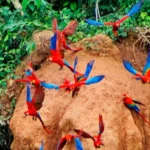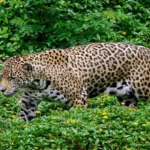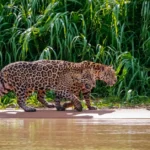
Facts and Curiosities About the Jaguar: The Largest Feline in the Americas

The jaguar (Panthera onca) is a powerful feline known for its great strength and unique characteristics. The wealth of facts and curiosities about the jaguar will surprise you. Discover facts and curiosities about the jaguar, the largest feline in the Americas. Its powerful bite allows it to hunt difficult prey, and its size makes it a top predator in American ecosystems. The Brazilian Pantanal is home to the largest concentration of jaguars in the world, making it an ideal destination for specialized photo tours.

Why visit the Pantanal?
The Pantanal is the largest freshwater wetland in the world, with nearly 20 million hectares spanning Brazil, Paraguay, and Bolivia. Its vast expanse shelters unique biodiversity: it is home to the highest density of jaguars on the planet, as well as millions of caimans, birds, and mammals. The Pantanal offers ideal conditions to see jaguars in the wild, thanks to its flat terrain, open vegetation, and abundance of water and prey. These features make the Pantanal an unparalleled natural sanctuary.
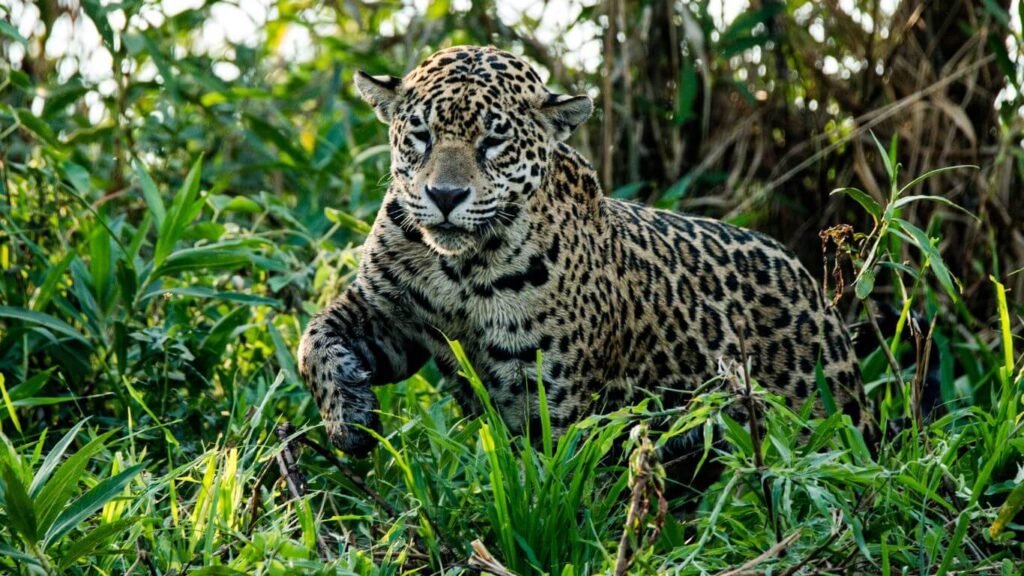
Facts and Curiosities About the Jaguar
These facts and curiosities about the jaguar reflect the Pantanal’s richness in jaguars and other species.
1. Most powerful bite of all felines
The jaguar has the strongest bite proportional to body size among all felines. Its bite is so powerful it can pierce through hard shells and skulls of its prey. This unique strength allows it to hunt difficult animals like turtles and caimans by crushing their shells and skulls to reach the meat. This is one of the most surprising facts and curiosities about the jaguar.
2. The largest feline in the Americas
The jaguar is considered the largest feline in the Americas. Specimens in the Pantanal can reach up to 1.80 meters and weigh over 100 kg (220 lbs). Its robust, muscular body sets it apart from other wild cats. Despite its size, the jaguar has lost half of its historical habitat due to hunting and deforestation. This is another of the facts and curiosities about the jaguar regarding its impressive size.
3. Excellent swimmers
Unlike many big cats, jaguars do not shy away from water; in fact, they are excellent swimmers. They can swim long distances in rivers and wetlands, where they hunt fish, turtles, and even caimans. This aquatic ability gives them an advantage in the Pantanal. This is another of the facts and curiosities about the jaguar.
4. Unique spot pattern
The jaguar’s fur varies from pale yellow to reddish-brown, with a white belly and black rosette-shaped spots on the neck, body, and limbs. Each jaguar has a unique pattern of spots, allowing for individual identification, like fingerprints. These complex rosettes (often with a central dot) provide effective camouflage in the jungle. This is another of the facts and curiosities about the jaguar.
5. Apex predator
The jaguar is the apex predator of its ecosystem. As an opportunistic hunter, it helps regulate populations of other species. It controls herbivores that could damage vegetation, maintaining the natural balance. Its presence ensures a healthy ecosystem. This role is another of the facts and curiosities about the jaguar.
6. Hunts with a unique technique
This feline prefers to silently stalk its prey before attacking. It hunts at dusk and night, ambushing near water when animals come to drink. Its powerful jaws can pierce the skulls of animals like tapirs or caimans, killing them instantly. This ambush technique is one of the facts and curiosities about the jaguar.
7. Wide territorial range
Each jaguar requires a very large territory to survive. It is found from the southwestern United States to northern Argentina. It prefers areas with water and dense vegetation. Its broad range ensures access to prey and resources. Its adaptability is another of the facts and curiosities about the jaguar.
8. Great dietary diversity
The jaguar is a strict carnivore and opportunistic hunter. Its diet is very diverse: it eats deer, tapirs, peccaries, capybaras, monkeys, iguanas, and even fish. It can feed on nearly any animal in its habitat. It even uses its powerful jaws to crack turtle shells and kill crocodiles. The variety in its diet is one of the facts and curiosities about the jaguar.
9. Ancient cultural symbolism
In many pre-Columbian cultures, the jaguar was worshipped as a god or symbol of power. It represented the energy of nature and was seen as a protector of the jungle. This ancestral respect highlights its cultural and historical importance in the Americas. This symbolism is another of the facts and curiosities about the jaguar.
10. Mainly nocturnal behavior
The jaguar is primarily nocturnal. It hunts at night when prey have limited visibility. They are also solitary and mark large territories. These habits help them avoid the heat of the day and other competitors. This social behavior is another of the facts and curiosities about the jaguar.
11. Ability to climb trees
Despite their weight, jaguars can climb trees. They use trees to rest or ambush prey from above. Trees also offer an escape route from danger. However, they prefer to spend time on the ground and in the water, where they hunt more often. This ability is another of the curiosities about the jaguar.
12. High adaptability
Jaguars adapt to a wide range of habitats. They live in tropical forests, savannas, wetlands, and even semi-arid areas. What matters most is having access to water and enough prey. This flexibility allows them to inhabit diverse regions like the Amazon, the Chaco, and the Pantanal. This adaptability is another of the facts and curiosities about the jaguar.
13. Threatened species
The IUCN classifies the jaguar as "near threatened". It has lost more than half of its historical range due to deforestation and illegal hunting. Although it is protected in most countries where it lives, it remains vulnerable to habitat fragmentation and human conflict.
14. Reproduction and parental care
Female jaguars usually have one to four cubs. The babies are born blind and helpless, and the mother cares for them diligently. Cubs stay with the mother for about two years to learn how to hunt. After that, they become independent and find their own territory. This upbringing is another of the facts and curiosities about the jaguar.
15. Importance for ecotourism
Jaguars attract nature-based tourism that benefits conservation. It’s estimated that each jaguar brings in far more economic value through tourism than the losses from livestock predation. Therefore, responsible wildlife observation contributes to protecting the species and its habitat.
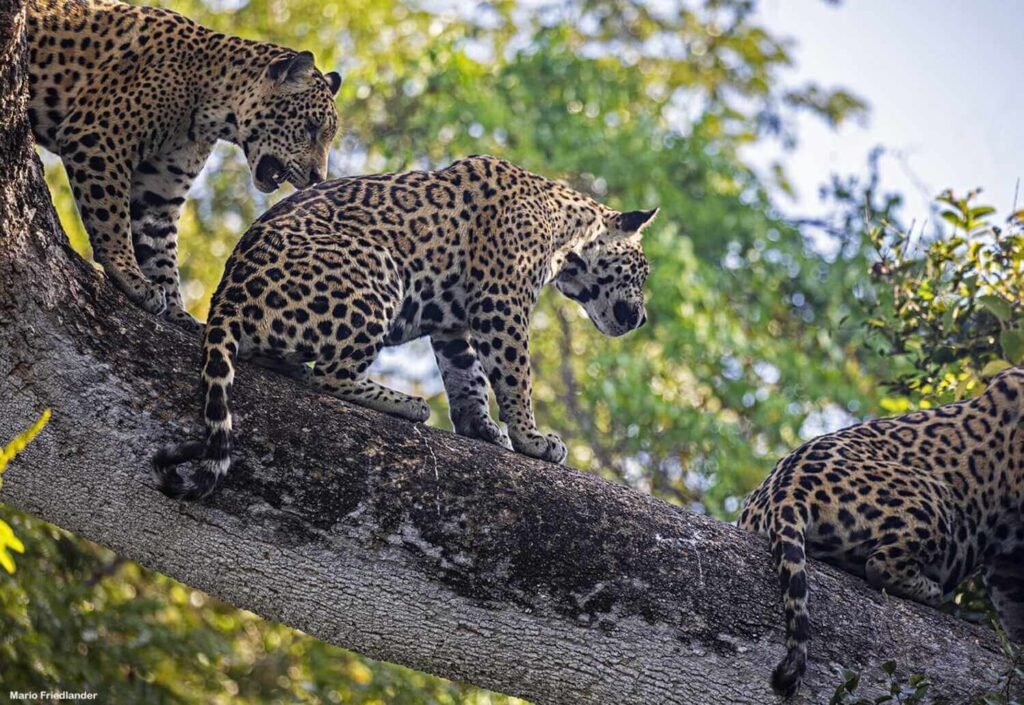
List of Tips for Observing Jaguars
- Hire a guided tour with local experts, who know where and how to observe without disturbing the wildlife.
- Travel during the dry season (June to October), when jaguars are more visible.
- Watch from rivers and trails, where jaguars hunt capybaras or caimans.
- Remain silent and be patient: the best encounters happen when one waits respectfully.
- Use binoculars and a telephoto camera, to observe without disturbing.
- Choose responsible operators like Lorenzo Expeditions, specialized in ethical photo safaris in the Pantanal.
Frequently Asked Questions about Facts and Curiosities About the Jaguar
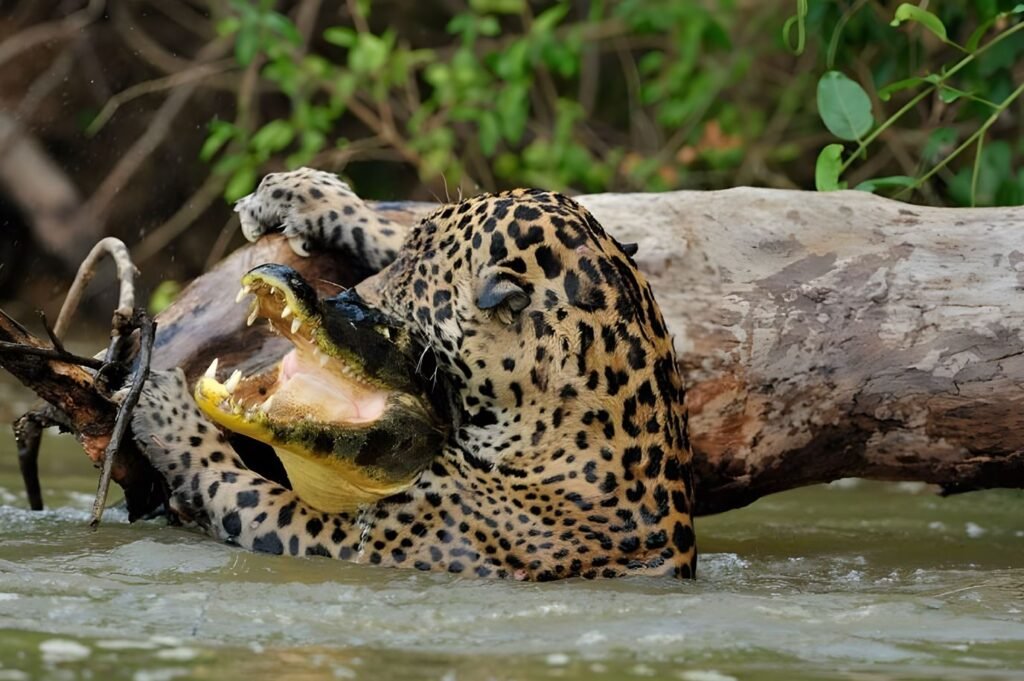
1. Where do jaguars live in the wild?
The jaguar inhabits much of Latin America, from the southwestern United States to northern Argentina. It prefers environments with water and vegetation, such as tropical rainforests, savannas, and wetlands. Its largest populations are in the Amazon basin and the Pantanal.
2. What do jaguars eat?
They are strict carnivores and opportunistic hunters. They feed on a wide variety of prey: from deer and tapirs to peccaries, capybaras, monkeys, iguanas, and even fish. Thanks to their powerful bite, they can hunt armored animals like crocodiles and turtles.
3. Why are jaguars important to the ecosystem?
As apex predators, jaguars regulate the populations of other species. They control herbivores that could damage vegetation, thus maintaining the natural balance. In addition, being indicators of healthy ecosystems, their presence promotes forest and jungle conservation.
4. When is the best time to see jaguars in the Pantanal?
The best time is during the dry season, from June to October. During these months, rivers are lower and animals concentrate in fewer areas, increasing the chances of sightings. Safaris are usually held at dawn and dusk, when the light is soft and the jaguars are active.
5. Which operators offer jaguar safaris?
Several ecotourism agencies in Brazil organize specialized tours to see jaguars. It is important to choose responsible operators with expert guides. We recommend Lorenzo Expeditions, whose multi-day photo safaris are designed to maximize the chances of seeing jaguars in the wild, always promoting area conservation.
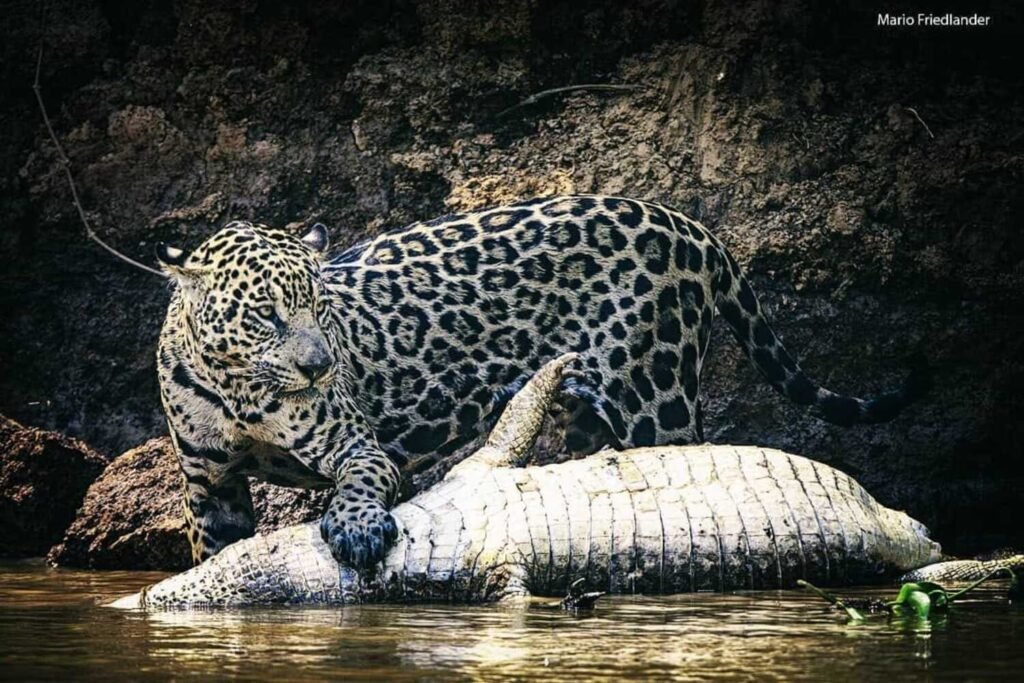
Facts and curiosities about the jaguar reveal that this feline is the largest in the Americas and has the most powerful bite among all felines. It is a top predator, excellent swimmer, and has a unique spot pattern. The Brazilian Pantanal, home to the highest concentration of jaguars, is the ideal place to learn about them and enjoy ecotourism. Contact us and book your photographic journey to the Pantanal.
Jaguar Observation Tours in the Brazilian Pantanal
Random Posts

How do I prepare for the Inca Trail?

 Español
Español  Português
Português 
 English
English 























